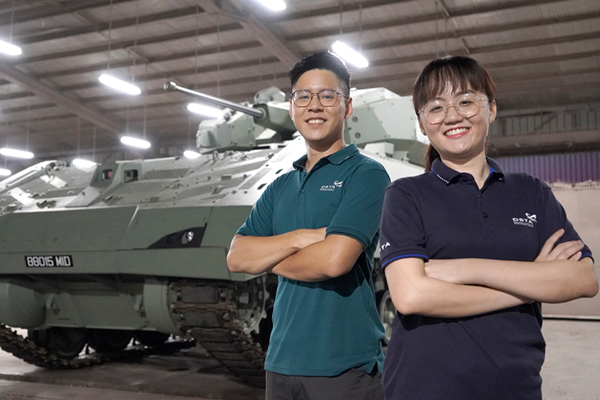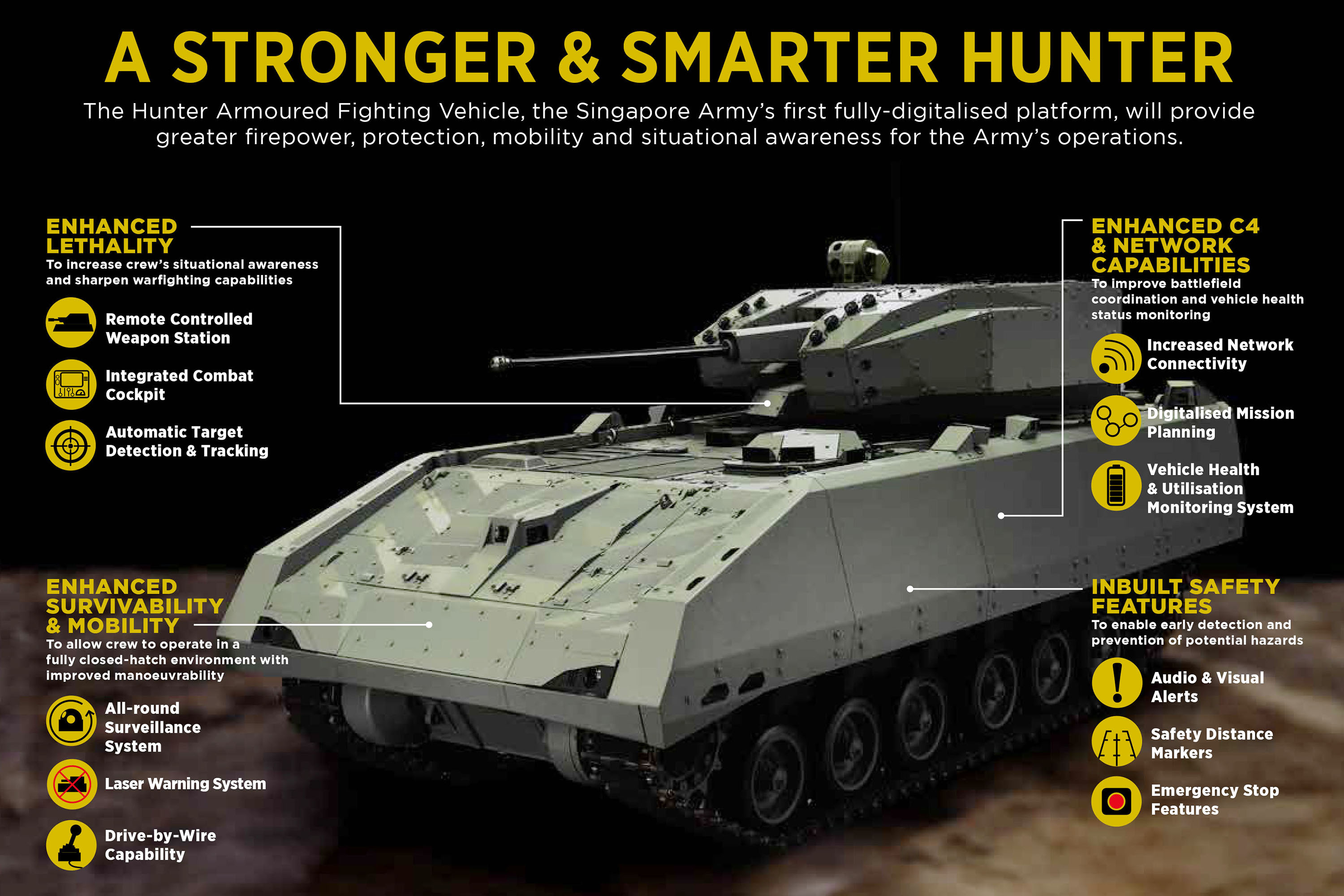02 Feb 2023
What comes to mind when you hear the word ‘Hunter’?
To us in DSTA, it means Singapore’s first fully digitalised Armoured Fighting Vehicle.
Developed by DSTA in collaboration with the Singapore Army and ST Engineering, the Hunter provides greater firepower, protection, mobility and situational awareness that enhances operational capabilities.
From the outset, our engineers implemented innovative design approaches to create a vehicle that is intuitive to use, train and maintain. It was the first Army programme that used 3D modelling extensively throughout the development process. This model-based systems engineering approach allowed for better visualisation and engineering analysis during design and technical reviews, without the need for physical prototypes.
Inside the vehicle, the vehicle commander and the gunner share a common console at the centre of their crew stations where they can operate the vehicle and access mission data collaboratively through touchscreens powered by the Army Tactical Engagement Information System (ARTEMIS).
We chatted with two of the team members – Project Manager (Land Systems) Jonathan Tan and Senior Engineer (Land Systems) Marissa Ang – to learn more.

Tell us more about your roles!
Jonathan: I am the Project Manager for the Remote Control Weapon Station. It is fully remote controlled, and is integrated with weapons, sensors, communications, protection and anti-tank guided missiles that can be fired even when the vehicle is moving over rough terrain. My role is to make sure all these parts come together and work with the vehicle as one system, and I am very proud to be given this responsibility.
Marissa: I’m involved in the development of ARTEMIS, the next generation tactical Command and Control system that allows the crew to operate the vehicle in a digitalised environment. With ARTEMIS, the Hunter is capable of digitalised mission planning. Through the use of smart systems, the operators are able to perform tasks much faster and more efficiently than before.
How was the Hunter designed and developed?
Jonathan: As advanced as it is, the Hunter is only as effective as the soldier operating it. Thus, we developed it first and foremost around the soldier, considering factors like ergonomics and user experience. And to stay ahead of rapid technology advancements, we developed a fully digitalised system which can be enhanced with new capabilities easily.
Marissa: We worked closely with the Army and industry partners and applied Design Innovation to ensure that the systems are intuitive and effective to use. For example, we designed the integrated combat cockpit around the users, ensuring that all functions are accessible within arm’s reach and can be activated within three clicks.
We adopted an iterative and agile approach – we met with Army and industry partners regularly to get feedback on the features, and developed these ideas quickly so that we can improve operational workflows. While developing the ARTEMIS, we also shadowed the operators to better understand their latent needs and introduce innovations to raise our soldiers’ fighting capability. Our close partnership with the maintenance team also allowed us to design for support, to minimise the vehicle’s lifetime maintenance cost.

Photo: MINDEF
What were your most memorable moments?
Jonathan: I was an Infantryman during my national service, so the largest gun I had operated then was the 7.62mm GPMG. When I observed the Hunter’s live firing for the first time, I was impressed by the immense power delivered in a three-round burst from its cannon. It was an incredible experience! These successful firings are a testament of all the hard work from the team behind the Hunter.
Marissa: It has to be when I first stepped into the Hunter! Everything looked really digital and high tech. With a flip of the switch, the Hunter started glowing as the electronics powered up. Three combat cockpit screens lit up and displayed different apps, each optimised for its role. It was fascinating and I wanted to learn more about the equipment inside the Hunter.
Both of you joined the Hunter programme midway. What was the experience like?
Jonathan: I joined the team after the programme had been in development for a few years. At that point, the amount of knowledge that I had to pick up quickly seemed daunting at first. And as you’d expect, most of the info can’t be found off the internet! Fortunately, I am surrounded by passionate and knowledgeable colleagues who are also great mentors and friends, and we levelled up together as a team.
Marissa: This is actually my first project in DSTA and it made me realised that working on the Hunter is very different from something you’d find commercially. For instance, when I buy a commercial laptop, I’d look at the specs, weight and aesthetics. For the Hunter, I had to study other factors such as power requirements, heat dissipation, ruggedisation and connectivity of each computer to the rest of the vehicle, just to name a few. Thankfully, I had very friendly and knowledgeable seniors and bosses who are very patient and generous with sharing their experiences. Hands-on learning is in our DSTA DNA, and there is no better way of growing as an engineer than to see your work take shape and spring to life.
Related Content:
